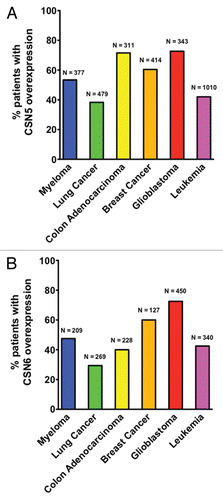Figures & data
Figure 1 Transcriptomic analyses of CSN5 and CSN6 overexpression in human cancer patients. Human cancer patient data sets were obtained from Oncomine and Gene Expression Omnibus. Data were analyzed using Oncomine analysis tools and Nexus Expression 2.0. Only patients with more than 40% increase in CSN5 (A) or CSN6 (B) mRNA levels compared with normal tissues were scored as “CSN5 overexpression” or “CSN6 overexpression,” respectively. N represented the total number of patients analyzed in each type of cancer.

Figure 2 A model for the role of CSN6 in regulating MDM2-p53 axis. MDM2 is self-ubiquitinated at K346, which leads to fast turnover. CSN6 binds to MDM2 at a region 294–384 aa, potentially blocking MDM2-mediated self-ubiquitination at K346 site. Thus, MDM2 is more stable and can enhance p53 ubiquitination, which, in turn, will block p53-mediated biological functions.

Table 1 Targeted gene disruption studies of COP9 signalosome gene